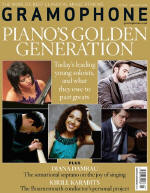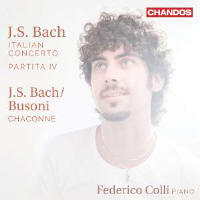Texte paru dans: / Appeared in: |
|
|
Outil de traduction (Très approximatif) |
|
|
THE MUSICIAN AND THE SCORE Bach-Busoni Chaconne
It’s well known that Busoni envisaged Bach’s Chaconne first as an organ work, and then transcribed this imaginary version for the piano using the techniques also found in his arrangements of, among other works, the D minor Toccata and Fugue, the C major Toccata, Adagio and Fugue, and the St Anne Prelude and Fugue. For some, this approach results in the loss of part of the Chaconne’s essence, namely the friction between the epic grandeur of the conception and the more intimate scope of its realisation – a friction we also find in, say, Beethoven’s Grosse Fuge and Hammerklavier Sonata. By imagining the work first as an organ piece, Busoni’s arrangement is effectively a double transcription. The music’s majestic opulence and nobility are amplified, thrillingly so, at the expense of the battle between concept and medium. I start by asking Federico Colli where he stands on this, and for him there is clearly a bigger issue at stake. ‘I think the point is a theological one. Why did Bach compose this piece, full of symbols, full of signs, full of evocations, full of transcendence, for an instrument – a marvellous instrument – that is limited in terms of its sound? We have form, and we have content. In the original solo violin version of the Chaconne, the content is incredibly deep, and the form, a set of variations on a repeating four-bar scheme, is very easy. Busoni recognised the deep nature of the content and created the best medium, for him, in order to show this content.’ This is already somewhat provocative. But Colli continues: ‘I ask myself why Ravel – one of the greatest orchestrators in history – didn’t make an orchestral transcription of the Chaconne, and I think the answer is that only someone who was able to understand the connection between the human soul and transcendence is able to imagine this transcription. Busoni once said that “Only the transcendent (the divine) deserves adoration”, and he chose this music for that reason. Busoni was not a great orchestrator, but he was a great pianist, and he turned to this material to create one of the greatest transcriptions of all time.’ I know the subject of transcendence is one we’ll return to, but first I ask whether Colli has looked at Brahms’s transcription, for left hand alone, which is more concerned with recreating the struggle between the content and its representation. ‘Yes, I love the Brahms arrangement, but for me nothing really compares with the Busoni. When I first heard the recording by Michelangeli [a famous account, recorded by the young Michelangeli in 1948, highlighted by Jed Distler in his recent Collection survey on this work (A/18)], it felt just like when you put in your contact lenses in the morning, and suddenly you can see everything clearly. I thought, this is it, this is the transcription that makes sense.’ The mention of Michelangeli makes me wonder whether Colli is a pianist who listens to other recordings. ‘I grew up with the Michelangeli recording, and the other one I love is Pletnev’s from Carnegie Hall, which is fantastic for its sound.’ Here, Colli picks up on precisely the quality of Pletnev’s live account that caught Jed Distler’s attention. Sonority is clearly Federico Colli is dazzled by Bach’s spirituality and Busoni’s pianism important to Colli, as indeed it was to Busoni, which has to be a good thing when playing this transcription. After an engaging conversation about further pianists, Colli pursues his theological line. There is a whole area of Bach research that deals with the religious character of Bach’s secular music, particularly the instrumental works, including identifying correlations between extracts of the music and specific parts of the Bible. With this in mind, Colli points to the very opening of the Chaconne. ‘Note that the music starts on the second beat, not the first, and the accent comes on this second beat. The effect is like someone walking with a limp. What is the reason for this? The character in the Bible who walks with a limp is Jacob, one of the most important characters in the Old Testament. Here, in this music, we are in the presence of Jacob.’ He elaborates further, and is both passionate and compelling. I suggest that it is part of Bach’s greatness that his music sustains many different ways of hearing and appreciating it. Colli agrees up to a point, but insists that since Bach saw God in everything he wrote, it is essential that we approach his music in this way. The narrative that he has constructed – outlined in his very personal booklet note for this recording – is highly detailed, and he concedes that other narratives may make sense for other people. But when I ask whether the idea of transcendence, of experiencing beauty through the search for truth, is something we can strive for even if we don’t view this music in such religious terms, Colli is adamant: ‘No. Not with Bach. If you are playing Bach and you want to understand his soul, you must understand his relationship with Christianity and the divine.’ I’m reminded that Steven Isserlis wrote a similarly personal note for his recording of the Cello Suites, where he also relates the music to a biblical narrative, and this pleases Colli.
|
|




